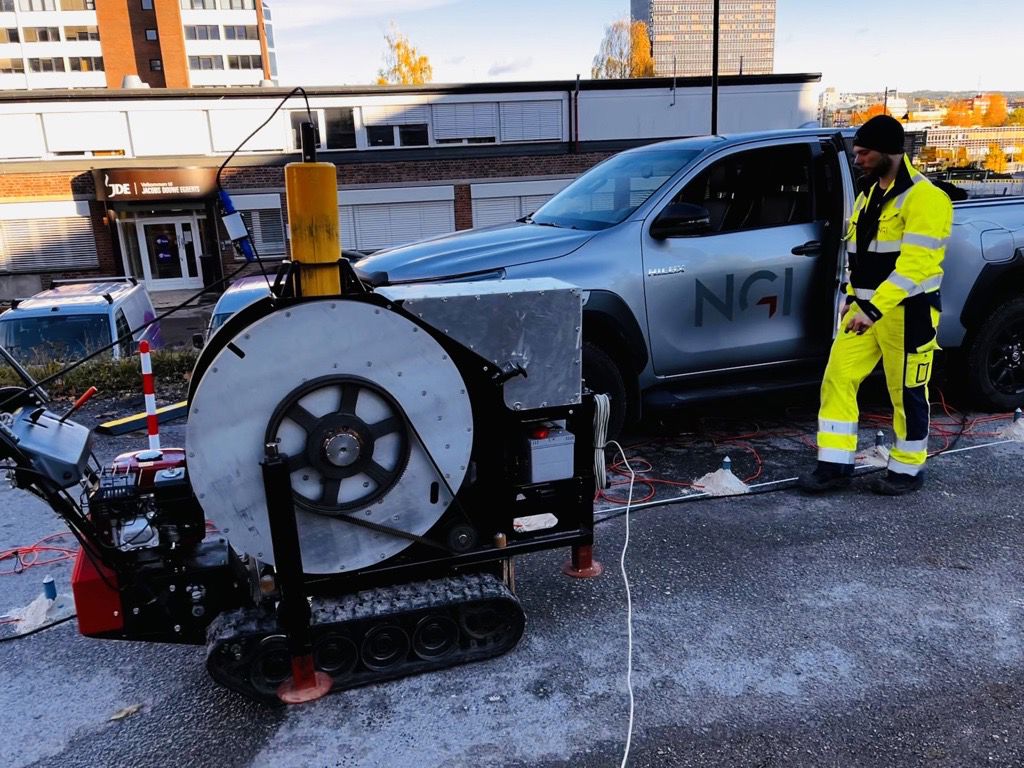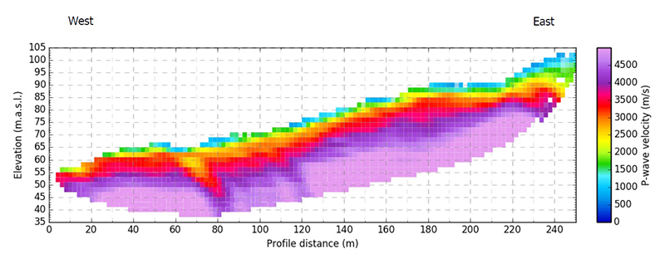Seismic surveying on land
Seismic methods are based on acoustic waves that propagate in the ground. The waves are usually generated using a source that produces either shock (so-called pressure waves, P-waves) or vibrations (so-called shear waves, S-waves).

The waves' speed and direction in the ground depending on the mass density. When the waves meet a difference between two different materials, some waves are reflected, some continue, while some follow the interface at high speed (so-called refraction). When the seismic waves reach the surface, they are detected by acoustic sensors (called geophones), and the seismic data is processed and interpreted.
NGI uses three-component digital geophones (wireless and wired) that detect both P- and S-waves and are not affected by electromagnetic noise. The system further allows real-time control of collected data and acoustic noise monitoring. Several different sources can be used, e.g. sweep vibrators or dynamite. NGI has developed a powerful P-wave source that provides up to 4 kJ repeatable strokes with a 160 kg weight.
Several seismic methods exist for different applications, depending on what kind of waves are generated and registered and how these are processed.
Refraction seismic
Refraction seismic is based on P-waves and is suitable for mapping the ground to 40-60 m. Geophones are installed along a straight line, and you shoot at the ground with a hammer or dynamite. The longer the line, the deeper the signals reach, and the shorter the distance between the geophones, the higher the resolution in the result.
Processing typically involves finding the difference between soil masses and rock (two-layer model) and modelling seismic velocity in the masses (tomographic inversion), which can be used to map zones of weakness in the rock.

Example of tomographic inversion of refraction seismic data. The profile indicates a zone of weathered rock at 80 m, which may be a zone of weakness.
Reflection seismic
Reflection seismic is based on detecting the reflected wave (as opposed to the refracted one) from the boundary layer in the ground. Due to noise from surface waves, this technique rarely provides good data near the surface but is rather suitable for more profound mapping, e.g. where one expects great thick layers of clay above the underlying rock.
Shear wave seismic
Reflection seismic can also be made based on shear waves, where a vibrator is used as a source instead of a hammer or dynamite. This is a preferred alternative if you need information about shear strength or stratification in soil deposits.
Surface wave seismic
Surface wave seismic or Multichannel analysis of surface waves (MASW) is a method of detecting and processing seismic surface waves. Unlike waves propagating inside a material, these are special waves that only move along a free surface (such as the terrain). Data collection usually takes place in the usual way with a geophone layout and a hammer or vibrator as the source. Still, the processing involves analysis of the frequency spectrum of the waves in addition to inversion. Unlike standard seismic, MASW can detect pockets with low seismic velocity.
Passive seismic and noise monitoring
It is also possible to extract sensible information from acoustic noise (e.g. on a construction site). One will typically analyse the frequency spectrum of the signals and perform either MASW or equivalent processing. In addition, wireless geophones can be used to monitor seismic activity - e.g. from landslides and rockfalls or mechanical vibrations.

Dyre Oliver Dammann
Head of Section Remote Sensing and Geophysics dyre.dammann@ngi.no+47 930 10 310